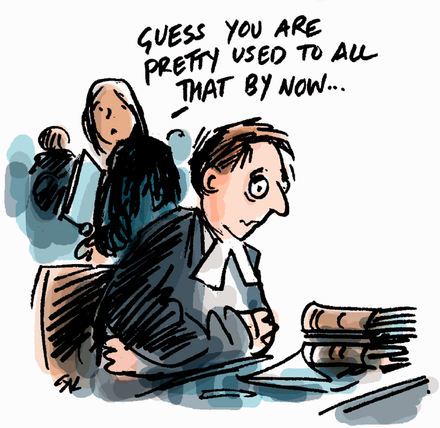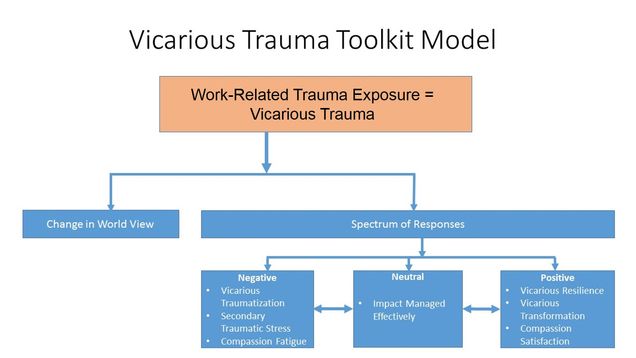Vicarious Trauma in the Legal System
The criminal justice system can cause or exacerbate trauma for all actors involved in each channel of the system. Criminal justice professionals as well as inmates experience trauma through law enforcement, courts and law, and corrections.
It is common to understand the trauma that can come from both law enforcement and correctional professionals due to high stress and the potential for violent scenarios. However, it is notable to realize that professionals within courts and law can experience trauma as well. A United Nationals article explains the vicarious trauma that judicial system professionals face (Vicarious Trauma, n.d.) Vicarious trauma is “the cumulative inner transformative effect of bearing witness to abuse, violence and trauma in the lives of people we care about, are open to and are committed to helping” (Vicarious Trauma, n.d.). Judges listen to evidence and make decisions with significant implications that affect members of society. This vicarious trauma can cause a negative world view, perceived threats to personal safety, loss of spirituality, or changes in self-identity, fear, empathetic distress, burnout, loss of relationships, mental or physical health issues, depression, or even coping with stress through food of substances” (Vicarious Trauma, n.d.). This proves that the trauma that judicial actors vicariously obtain can affect both their personal and professional lives.
There are three different types of reactions to trauma exposure including negative, neutral, and positive reactions. Negative reactions include vicarious traumatization leading to secondary traumatic stress, compassion fatigue, and critical incident stress (Department of Justice, n.d.). Neutral reaction signifies a person’s resilience, experiences, support, and coping strategies that manage the traumatic material. Positive reactions lead to vicarious resilience and involves drawing inspiration from victim’s resilience to strengthen their own mental an emotional fortitude.
Luckily there has been efforts to address the trauma that judicial professionals have identified. First, the National Council of Juvenile and Family Court Judges (NCJFCJ) include wellness aspects in their training conferences to build resilience for judges. They explain ideas of breathing techniques, nutrition, physical exercise, mindfulness practices, self-compassion, and advice from experts to develop tools to reduce stress and mitigate vicarious trauma (Vicarious Trauma, n.d.). Educating professionals early on how to deal with vicarious trauma offers these individuals the best opportunity to have positive outcomes when they face these situations.
Additionally, there are suggestions for coworkers, supervisors, and family members who might identify someone dealing with vicarious trauma. This involves reaching out and talking to them, supporting them, connecting them to resources, referring them to organizational support, allowing flexible work schedules, creating a positive physical space at work, maintaining routine, and more (Department of Justice, n.d.).
While the risks of vicarious trauma is detrimental to both physical and mental health in personal and professional lives, there are solutions. It is essential to educate professionals within the legal system about vicarious trauma, so they have both the knowledge and resources to combat it.


References
Department of Justice. (n.d.). What is vicarious trauma?: The Vicarious Trauma Toolkit: OVC. Office for Victims of Crime. https://ovc.ojp.gov/program/vtt/what-is-vicarious-trauma
Vicarious trauma experienced by judges and the importance of healing. (n.d.). https://www.unodc.org/dohadeclaration/en/news/2021/26/vicarious-trauma-experienced-by-judges-and-the-importance-of-healing.html
2 comments
Your post highlighting the different reactions to trauma and adds depth to an important conversation. It’s reassuring to see the effort being made to address these issues, such as the wellness initiatives from the National Council of Juvenile and Family Court Judges that you mentioned. Having professionals armed with strategies like mindfulness, self-care, and organizational support is a positive step for building the strength it not only takes to overcome but to also endure.
Your blog is an excellent reminder that trauma in the criminal justice system is not limited to those incarcerated or who are victims of crime. An all-encompassing approach to justice should include the well-being of those who serve within the system as well, ensuring they have the tools and support necessary to handle the emotional toll of their roles.
Great job bringing attention to this important issue!
This is a really important topic. I feel like people don’t talk about criminal justice law officers that much. When people think of security and first responders who keep us safe, most don’t think about correctional officers. There is also research showing that correctional officers and other similar professionals having high rates of cardiac emergencies than other professions due to the stress of the job. Correctional mental health teams need to think of COs as their clients as well as the inmates
Comments are closed.